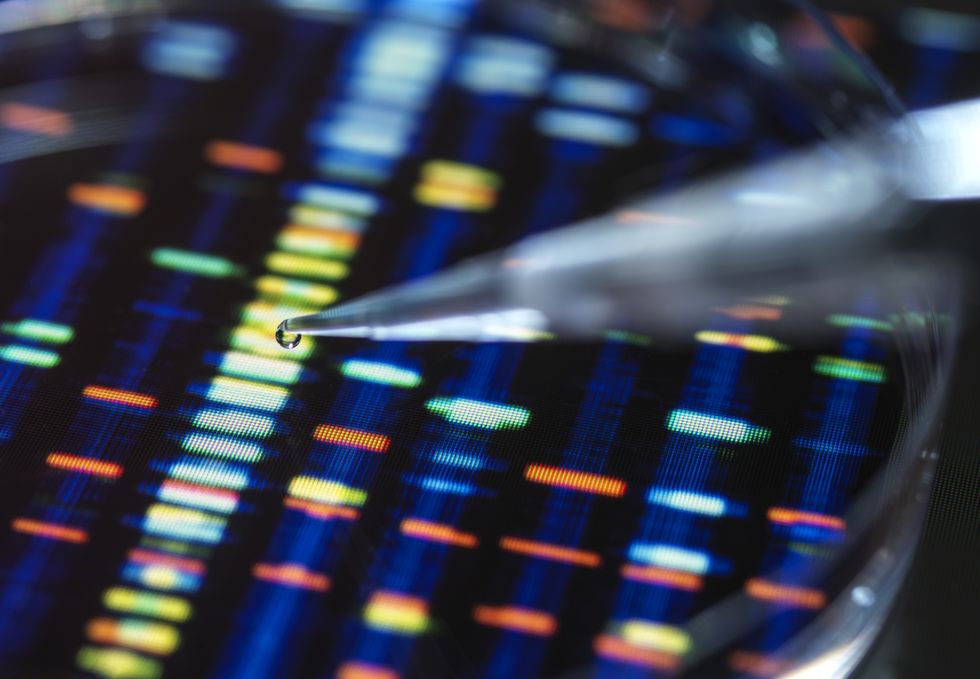
Cherished heirlooms, old photographs, journals, and stories passed down through generations have long formed the narrative backbone of a family’s ancestral story. And in recent years, thanks to incredible advances in genetics and DNA sequencing technology, people around the world can now trace their ancestry through their genome.
There are now dozens of companies that sell, manufacture, and distribute DNA test kits directly to consumers, and there are even DNA test kits for your dog or cat.
? Science is on our side.
Some of these kits claim their results will tell you where your ancestors came from. Some claim they can tell you what your health risks are, give you nutrition tips, or even examine your personality and behavior.
More From Popular Mechanics

Although many kits promise to deliver enticing personal information, the results are probably not as accurate as customers assume, experts say. And what those companies plan to do with their customers’ genetic information—and how they plan to keep such personal data secure—is not always clear.
DNA Test Kits, Compared
Among the most popular DNA ancestry kits on the market today are kits sold by AncestryDNA, a genealogy and genomics company headquartered in Lehi, Utah, and 23andMe, a biotechnology company headquartered in Sunnyvale, California. The kits from these companies and most of their competitors range in price from $100 to $300. Both AncestryDNA and 23andMe offer services that will help determine your ancestry and give you information on personal traits–things like light or dark hair, a fear of heights, dandruff, and even your preferred ice cream flavor.
Kits from companies such as MyHeritageDNA, FindMyPast, FamilyTreeDNA, and LivingDNA focus primarily on ancestry and mapping your family tree, with a few options for finding information on personal traits. Some companies, such as Dynamic DNA Laboratories, claim that in addition to predicting your ancestry, they can use your DNA to predict your nutritional and fitness needs, and even tell you about your tolerance for cannabis products.
While all of the aforementioned kits include a lot of information, they only sequence the portions of your DNA needed to gather that data.
Nebula Genomics, a San Francisco-based biotechnology company founded by famed controversial geneticist George Church, will sequence 100 percent of your genome–all 6.4 billion base pairs–for $300. For $1,000, the company also offers what they claim to be the most accurate comprehensive DNA test on the market, with “ultra-high” genetic accuracy. However, what exactly makes the $1,000 kit more accurate than the $300 kits, and what additional information you’ll be able to glean from having your entire genome sequenced is unclear. (You can find information and reviews for more than 50 different DNA test kit companies at DNAWeekly.com.)
How Do DNA Test Kits Work?
First, a little refresher on DNA, which is short for deoxyribonucleic acid. Every cell in our body contains DNA in its nucleus. DNA is made up of two chains of four chemicals called nucleotide bases—named adenine (A), thymine (T), guanine (G), and cytosine (C)—which are paired together to form a twisted ladder-like structure called a double helix. The human genome consists of more than six billion of those nucleotide base pairs arranged in specific sequences that code for between 20,000 and 25,000 different genes. Most of those genes are the same in every human, but less than 1 percent of those genes are just slightly different, making every person unique.
DNA test kits require the customer to swab their cheek or spit into a vial, which the customer then seals in a sterilized envelope or container and sends to the testing company for analysis. The companies then extract and sequence the DNA, which means they figure out the specific order of nucleotide base pairs that form that person’s genes. Then they compare those results to their database of other human DNA sequences. The technology companies use to sequence the DNA is generally the same across companies, but specific materials and protocols are proprietary, as are the algorithms they use to determine how the sample data relates to their (also proprietary) database of genetic information.
There are a few types of DNA these tests may analyze. Human DNA is packaged up in 24 tightly wound X-shaped structures called chromosomes. Autosomal DNA is what’s contained in your 22 non-sex chromosomes, equal parts of which came from either parent. Analyzing this DNA gives the most comprehensive picture of your ancestry and genetics. Mitochondrial DNA (mtDNA) is only on the X-chromosome as it comes exclusively from the mother. Analyzing mtDNA will parse out maternal ancestry exclusively. Some companies will test Y-DNA, which is the DNA inherited from the father and present only in males. Similarly to mtDNA, Y-DNA will exclusively identify paternal ancestry.
Once the DNA sequence is determined, the companies use their proprietary algorithms to compare the findings with their own database of genetic information. While there isn’t a specific gene to label a person as “English” or “South African,” there could be genes or groups of genes that are generally characteristic of people who claim to have similar ancestry. So, for example, if 3,000 people have the same 12 genes and most of those people believe their ancestors are from South America, then the algorithm will suggest South American ancestry when it matches those genes in the company’s database of genetic information.
How Accurate Are Your Results?
Every company has their own genetic database–none of which are comprehensive or complete, says Dr. Ramya Rajagopalan, an expert in bioethics and associate director at the Center For Empathy and Technology at the University of California San Diego. Because none of these databases capture all of the global variation in the human genome, it’s impossible for them to fully and accurately capture a person’s ancestry, she says.
In order to use DNA to trace a person’s ancestry, researchers must first delineate groups of individuals with similar genetic traits as being representative of different areas of the world. But that’s an imprecise science, Rajagopalan says. In our increasingly mixed world, it’s hard to definitively say that certain genes are representative of prototypical Japanese, or prototypical European populations. “It’s very much the researchers making a subjective kind of claim or assumption about who counts as that reference against which they compare the individual’s DNA to determine their origins or their ancestry,” Rajagopalan says.
According to an Ancestry spokesperson, “AncestryDNA calculates your ethnicity estimate by comparing your DNA to a reference panel made up of over 40,000 samples from people with a long family history in one place or as part of one group. Ancestry reads the hundreds of thousands of DNA markers it measures with 99 percent accuracy.”
A spokesman for 23andMe describes the DNA ancestry results as “highly accurate” and explained that their results are conservative estimates, “so if we cannot match a DNA segment to a specific country within a reference population, we assign customers to a broader region within that population.”
This means DNA ancestry results will always have some level of error associated with them, as they are only estimates based on assumptions made by the company’s team of researchers and analysts.
The tests that claim to give you information about the best diet for your genetics or the best fitness regime are also probably far less reliable than many customers assume because scientists don’t have a way to figure those things out yet, Rajagopalan says. “We know that there are lots of social and cultural factors that can really influence those [kinds of] traits,” she says, and how genetics plays a role is still unknown. There’s a gap between what the companies are promising to consumers or what the consumers believe they are receiving, and what the companies are actually delivering, she says.
This is not to say the tests are completely worthless. Certain health conditions, such as cystic fibrosis or sickle-cell anemia, are well understood to be genetic, and some consumer DNA test kits may be capable of identifying the genes associated with those kinds of diseases. However, consumer-grade DNA tests may not always be as rigorous as clinical-grade DNA tests that your doctor’s office may order for you, Rajagopalan says.
Companies that offer clinically-validated genetic testing often have the consumer order the test through their primary care physician, she says, to ensure there is backend support for the customer in terms of consenting, understanding the test, and having support once they receive the results.
How Private and Secure Are Your Results?
When companies sequence all or part of your genome, they’re keeping a copy of the results. This may seem like a positive thing if, for example, you ever want the opportunity to reanalyze your results. But this also means your personal genetic data is permanently in someone else’s hands.
Most of the major DNA test kit companies, including AncestryDNA and 23andMe, promise that their customers’ genetic data is securely controlled and never shared with any other entity unless the consumer gives explicit permission to do so. The genetic data stored on their servers is just as secure as other companies with sensitive personal information, such as a credit card company. But when a data breach happens to a DNA company, there is a serious risk of sensitive, identifiable, health-related data being disclosed, says Sonia Chiasson, an associate professor in the School of Computer Science at Carleton University in Canada. “If your credit card data is breached, it’s a pain but you can eventually recover,” she says. “You can’t change your DNA, so consequences of an incident are potentially lifelong.”
And customers probably don’t fully understand the terms of service when they agree to let these companies access their genetic data, “so yes, people’s data is probably being used in unexpected ways,” Chiasson says. No matter how comfortable people are with having their genetic data used for other purposes, everyone should be allowed to make their own well-informed decision about it, she says. “Right now, I don’t think we really have ‘informed consent’ because it’s hard for people to really know what’s happening with their data,” she says. “It’s also really hard to imagine all the potential consequences to themselves or to their genetic relatives.”
When a person decides to share their genetic data with one or more of these companies, they’re also sharing the data of their genetic relatives, whether those relatives consented or not. “So in effect, you might be compromising the privacy of your grandparents, parents, siblings, children, and relatives who aren’t even born yet,” Chiasson says.
It’s impossible to predict what these companies will do with their genetic databases years from now, so the companies can’t really guarantee the information won’t be used to the detriment of people’s privacy decades from now, says Maria Ávila-Arcos, an assistant professor in the International Laboratory for Human Genome Research at National Autonomous University of Mexico. “So I think it’s quite unfair particularly for little kids who will have to live with the potential risks of this decision for longer than their parents,” she says.
Because of their concerns about privacy and the unknowns about how the data may be used years from now, neither Ávila-Arcos or Chiasson feel comfortable using any direct-to-consumer DNA ancestry test. “I get that there are obvious benefits to doing these DNA tests, otherwise people wouldn’t do them,” Chiasson says. “But there are also real risks and potential consequences.”

Kimberly is a freelance science writer with a degree in marine biology from Texas A&M University, a master’s degree in biology from Southeastern Louisiana University and a graduate certificate in science communication from the University of California, Santa Cruz. Her work has been published by NBC, Science, Live Science, Space.com and many others. Her favorite stories are about health, animals and obscurities.
















